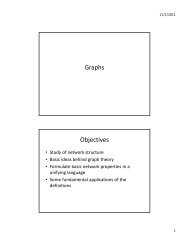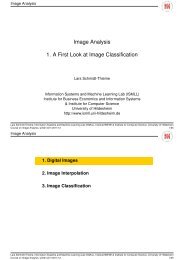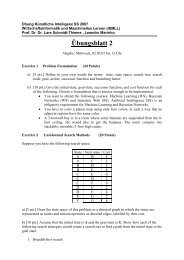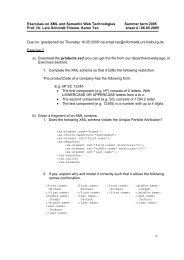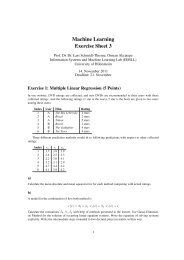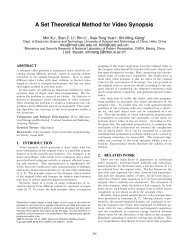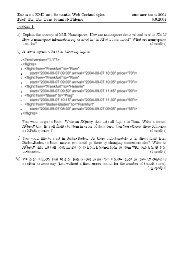Machine Learning 3. Nearest Neighbor and Kernel Methods - ISMLL
Machine Learning 3. Nearest Neighbor and Kernel Methods - ISMLL
Machine Learning 3. Nearest Neighbor and Kernel Methods - ISMLL
Create successful ePaper yourself
Turn your PDF publications into a flip-book with our unique Google optimized e-Paper software.
<strong>Machine</strong> <strong>Learning</strong> / 2. k-<strong>Nearest</strong> <strong>Neighbor</strong> Method<br />
Accelerations: partial distances<br />
In practice, nearest neighbor classifiers often can be accelerated<br />
by several methods.<br />
Partial distances:<br />
Compute the distance to each training point x ′ only partially, e.g.,<br />
r∑<br />
d r (x, x ′ ) := ( (x i − x ′ i) 2 ) 2, 1 r ≤ p<br />
i=1<br />
As d r is non-decreasing in r, once d r (x, x ′ ) exceeds the k-th<br />
smallest distance computed so far, the training point x ′ can be<br />
dropped.<br />
This is a heuristic:<br />
it may accelerate computations, but it also may slow it down<br />
(as there are additional comparisions of the partial distances with<br />
the k smallest distance).<br />
Lars Schmidt-Thieme, Information Systems <strong>and</strong> <strong>Machine</strong> <strong>Learning</strong> Lab (<strong>ISMLL</strong>), Institute BW/WI & Institute for Computer Science, University of Hildesheim<br />
Course on <strong>Machine</strong> <strong>Learning</strong>, winter term 2007 27/48<br />
<strong>Machine</strong> <strong>Learning</strong> / 2. k-<strong>Nearest</strong> <strong>Neighbor</strong> Method<br />
Accelerations: search trees<br />
Search trees:<br />
Do not compute the distance of a new point x to all training<br />
examples, but<br />
1. organize the training examples as a tree (or a DAG) with<br />
• sets of training examples at the leaves <strong>and</strong><br />
• a prototype (e.g., the mean of the training examples at all<br />
descendent leaves) at each intermediate node.<br />
2. starting at the root, recursively<br />
• compute the distance to all children of the actual node <strong>and</strong><br />
• branch to the child with the smallest distance,<br />
<strong>3.</strong> compute distances only to training examples in the leaf finally<br />
found.<br />
This is an approximation.<br />
Lars Schmidt-Thieme, Information Systems <strong>and</strong> <strong>Machine</strong> <strong>Learning</strong> Lab (<strong>ISMLL</strong>), Institute BW/WI & Institute for Computer Science, University of Hildesheim<br />
Course on <strong>Machine</strong> <strong>Learning</strong>, winter term 2007 28/48




